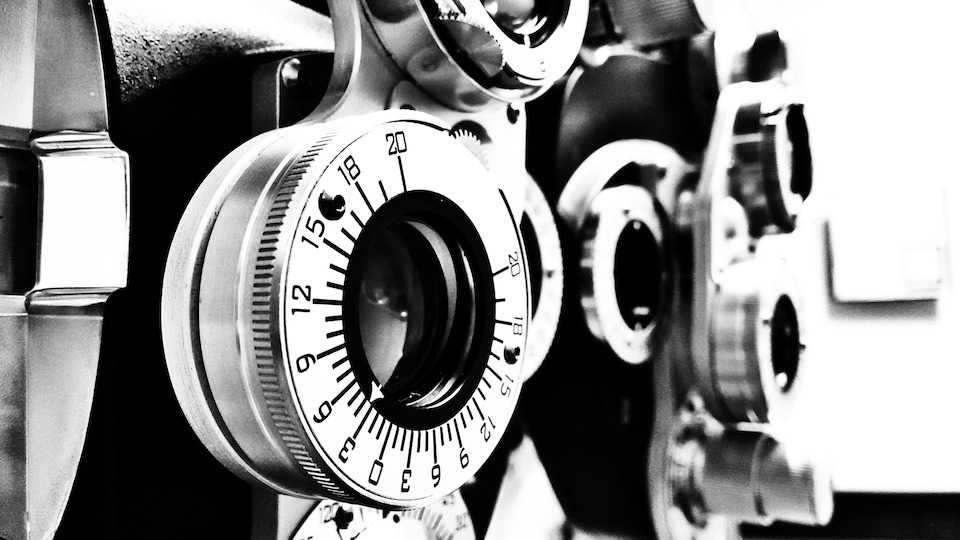Learn The Meaning of Nearsighted vs Farsighted (And Also Presbyopia)
Some people in life are just blessed with perfect vision. But others may need correction such as a pair of glasses or contact lenses in order to see. Those individuals may be nearsighted or farsighted (and may also have astigmatism).
Let's break down what each of those mean!
Nearsighted
Can you read up close without your glasses or contact lenses? Is it difficult to see in the distance? If yes, then you may be nearsighted . Ok, what does this really mean?
Nearsighted also goes by the term myopia or shortsighted
When we look at an object in the distance, an image of that object is projected onto the back part of our eye called the retina. It is similar to how a movie projector projects an image of the movie film onto a screen, but in reverse. In order to get the object in focus for us to see it clearly (the screen), the eye has to focus that image exactly into a very small dot on the film or retina (since the eye and retina are small).
Nearsighted vision can make the movie screen blurry

Luckily, for many people the eye develops the exactly right focusing power. For some less lucky people, nearsighted people, the eye focuses the image to a dot right in front of the retina. This causes things to be blurry once the image actually reaches the retina. Now, through the magical physics of optics, you can push that focus onto the retina by bringing objects closer. Hence, you can see near objects; you are near-sighted.
Farsighted
Are things blurry in the distance? Do things get even worse when you see up close? Does your vision without glasses continue to get worse year after year? You may be farsighted.
Farsighted also goes by the term hyperopia or longsighted.
So how is farsighted different from nearsighted?
Nearsightedness or myopia causes the projected image to not make it all the way to the retina. However, by bringing objects closer, you can eventually get things in focus.
Farsightedness on the other hand is the exact opposite. Objects in the distance completely miss the retina and focus “behind” it (but of course they don’t really come to a focus since light can’t actually pass through the retina).
Even worse, bringing objects closer cause it to go even more out of focus! If it were possible to push objects out further than infinity then maybe a farsighted person could bring things in focus on their retinas, but alas, that is impossible.

Up close very blurry; Image by Den man tau, CC BY-SA 4.0, via Wikimedia Commons
Thus, you see objects better far away in the distance; you are far-sighted. Fortunately for the farsighted individuals, the lens inside the eye is able to focus through some of that prescription - for a while. Thus most people with farsighted prescriptions don’t really know that they have any refractive issue until much later in their life. That is, until something called presbyopia occurs.
Presbyopia
The need for reading glasses

The need for reading glasses; Image by Dariusz Sankowski from Pixabay
Starting in their early 40’s, something really really annoying happens to our vision. Even those lucky people that are born with great perfect vision. This something is called presbyopia but sometimes also called becoming farsighted.
Let's first focus on what people with perfect vision experience during presbyopia.
Presbyopia when you've never needed glasses
At first, these people find that they can't hold things up real real close anymore. They start to hold things out a further distance. But soon, their arms “become” too short and they are forced to pick up reading glasses and/or progressive glasses to make out the small objects. These people have gone though life's rite of passage called presbyopia or the loss of the reading vision.
Presbyopia is caused by the natural lens inside eye becoming rigid over time. This is the same lens that becomes a cataract over time. As this lens becomes rigid, it is no longer flexible enough to change focus onto objects up close. The near vision progressively gets worse over the years.
But presbyopia doesn't only affect people with perfect vision. Presbyopia affects everyone! However, not everyone is affected in the same way.
The nearsighted individuals

Some people can read without reading glasses; Image by Carlo Dolci, Public domain, via Wikimedia Commons
Some people get lucky and don’t even need to worry about reading glasses! How can this be? These lucky people are those that have a mild amount of nearsightedness.
Nearsightedness becomes a superpower during presbyopia. However there is only a certain range where this works. If you have too little nearsightedness, you still will require reading glasses but will have better distance vision. Conversely, if you have too much nearsightedness, you have to hold things much much closer than comfortable in order to actually read things. You pseudo-benefit from that high amount of nearsightedness.
But being nearsighted isn’t all good news. You still can’t see in the distance. With your glasses or contact lenses on you still join the rest of the crowd and have difficultly reading when presbyopia kicks in. So, nearsighted people either go into progressive glasses, wear mono vision or multifocal contact lenses or just simply lift up their glasses whenever they want to read. But it’s still nice knowing that you can read without glasses if you need to.
Farsighted people suffer more with presbyopia
For much of their life, farsighted people have it pretty good. Unless they have astigmatism or a severe prescription, they really don’t have to worry much about glasses to see and get by. All of that changes with presbyopia.
As the lens loses its natural ability to accommodate or see up close, farsighted people are hit first and hit worst than the nearsighted folk. You see, this ability of the lens to accommodate allows it to focus through certain prescriptions and give good vision. Farsighted prescriptions being one of them (too much extra prescription in a nearsighted person being the other). The natural lens gobbles up this extra prescription and makes it appear like there is no prescription left. Because of this, many farsighted people don’t even know they are farsighted when they are young.
But this lens can only do so much. After focusing through the extra prescription in a farsighted person, this lens then must use its remaining strength to focus up close. And the strength of this lens gets worse with time. As the strength of this lens decreases, it has less and less remaining ability to focus up close. This causes the up close vision to decline earlier in a farsighted individual since their lens is already working too much focusing through their prescription.
On top of that, eventually the lens reaches a point where it can no longer even focus through the farsighted prescription! At this breaking point, the distance vision (which has been perfect for life) starts to become blurrier and blurrier. Nothing is in focus anymore without correction.
So far sighted people have it worse during presbyopia.
Summary
While there are many subtle differences between nearsighted and farsighted individuals, the very short answer is that nearsighted individuals can see better up close but require glasses for distance, while farsighted individuals can see better in the distance but may require glasses up close and eventually even for distance as well.
Also check out What's The Difference Between Short Sighted vs Long Sighted? on EyeMountain.com to learn more
Related Articles
Please note: The general information provided on the Website is for informational purposes only and is not professional medical advice, diagnosis, treatment, or care, nor is it intended to be a substitute therefore. See the Disclaimer and Terms of Use for more information
